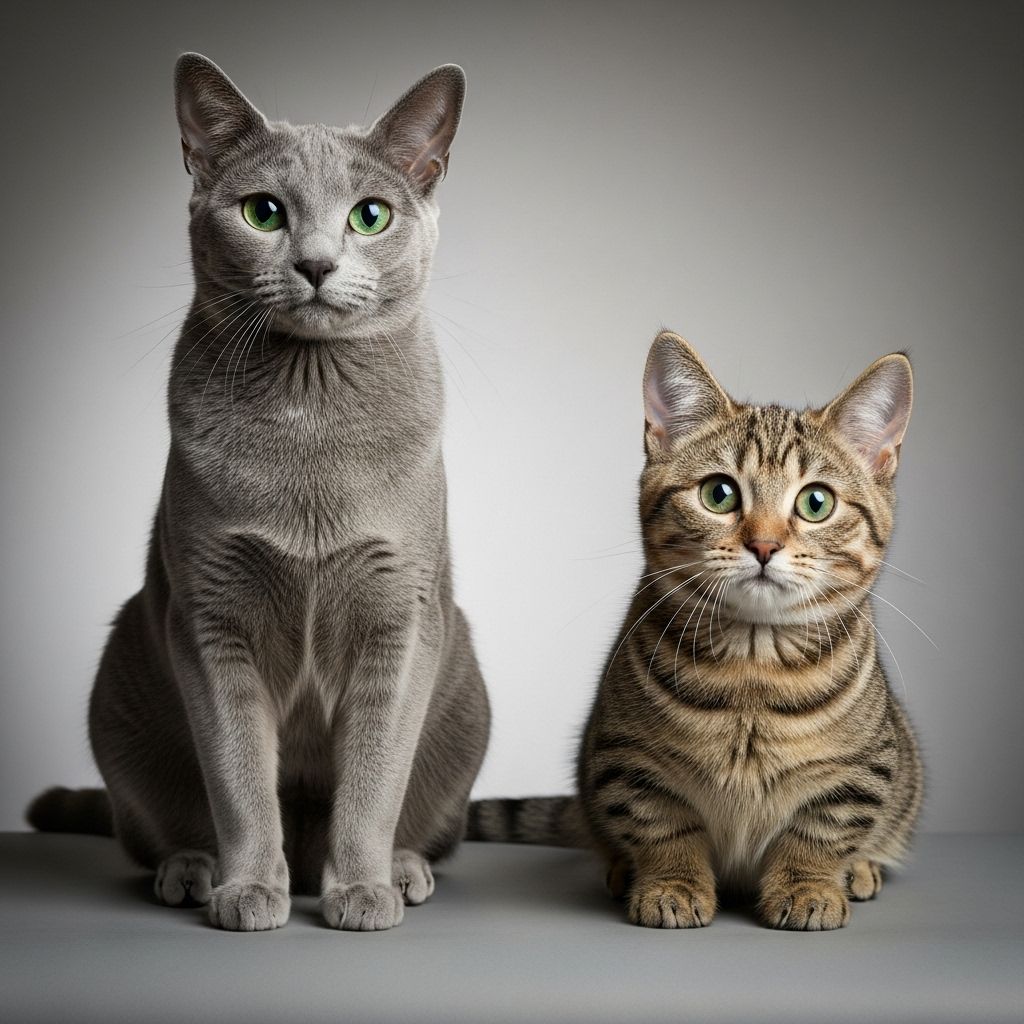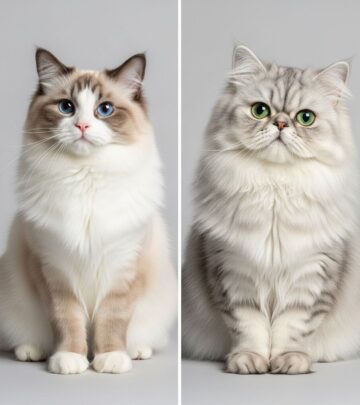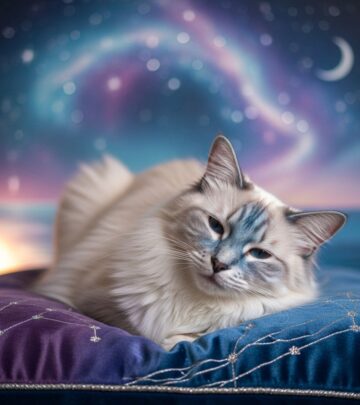Russian Blue vs. Munchkin Cat: Breed Comparison for Owners
Explore the characteristics, personality, health, and suitability of Russian Blue and Munchkin cats to help you choose your next feline companion.

Russian Blue vs. Munchkin Cat: Breed Comparison Guide
If you’ve ever found yourself torn between adopting a graceful Russian Blue and the playful Munchkin cat, you’re not alone. These two breeds are among the most distinct and popular cats, each offering a unique set of traits that can make them an ideal — or challenging — companion. In this detailed comparison, we explore the defining features, personalities, care requirements, and suitability of each breed, so you can make an informed decision for your household.
Breed Overview
| Feature | Russian Blue | Munchkin Cat |
|---|---|---|
| Origin | Northern Russia (Archangel Port) | United States (genetic mutation discovered in the 1980s) |
| Size | Medium (8–15 lbs) | Small to medium (5–9 lbs), with short legs |
| Coat | Short, dense, double-layered blue-grey fur with silver sheen | Short or long, various colors and patterns |
| Eye Color | Vivid green | Various (commonly gold, green, or blue) |
| Activity Level | Moderate to high | High |
| Temperament | Affectionate, reserved, intelligent, loyal | Playful, outgoing, curious, sociable |
| Lifespan | 15–20 years | 12–15 years |
| Best for | Individuals/families seeking a quiet, loyal, low-shedding companion | Families, children, multi-pet households, those seeking playful cats |
Appearance and Physical Traits
Russian Blue
The Russian Blue is renowned for its elegant, slender build paired with a velvety, thick blue-grey coat that shimmers with silver tips. These cats boast triangular heads with broad foreheads and large, pointed ears set high on the head. Their striking emerald green eyes are one of their most distinctive features, lending them an air of intelligence and gentleness. Legs are long and slender, supporting a graceful and athletic physique. Despite their fine-boned appearance, Russian Blues are quite muscular, and their signature double coat makes them appear more robust than they truly are.
- Coat Description: Dense, plush double coat (short hair, low shedding)
- Color: Blue-grey with silver sheen
- Eye Color: Vivid green
- Paw Pads: Mauve to pinkish-lavender
- Build: Fine-boned yet muscular, with long legs
Munchkin Cat
The Munchkin cat’s most distinctive feature is its short, stubby legs, the result of a natural genetic mutation. Despite their reduced leg length, Munchkins are well-proportioned cats and come in a variety of colors, patterns, and coat lengths (both short- and long-haired varieties). Their bodies are compact and muscular, with broad chests and well-rounded contours. Munchkins have expressive walnut-shaped eyes that can be any color, and their ears are either upright and medium-sized or slightly angled, depending on the individual.
- Coat Description: Soft, plush (short or longhair; moderate shedding)
- Color: Wide range, including solids, tabby, calico, and more
- Eye Color: Varies widely (gold, green, blue)
- Build: Compact with prominent short legs
Personality and Temperament
Russian Blue
The Russian Blue is celebrated for a gentle, sweet-natured, and loyal personality. These cats are highly intelligent with a well-developed sense of routine and an ability to learn quickly. Russian Blues tend to form a strong attachment to one person but remain affectionate with all family members. They are not typically lap cats, but they will follow their favorite person around the house, seeking companionship. Shy and reserved around strangers, Russian Blues often hide during large gatherings or when new people visit.
- Devoted and loyal; bonds with primary caretaker
- Shy but loving—particularly with familiar people
- Enjoys interactive play and puzzle toys
- Noted for independence; tolerates alone time well
- Prefers peaceful, predictable environments
- Can be sensitive to cleanliness and routine
Munchkin Cat
Munchkin cats are known for their buoyant, playful, and outgoing nature. They relish attention and tend to be friendly with both family members and strangers. Munchkins remain kitten-like in energy and curiosity throughout their lives, making them a constant source of entertainment. Their social disposition makes them well-suited for families with children or other pets.
- Extremely playful and energetic
- Outgoing and sociable; welcomes new people and animals
- Athletic (despite short legs), skilled at running, jumping, and playing fetch
- Loves interactive games and puzzle feeders
- Adapts easily to new environments and situations
- Ideal choice for active families
Care and Maintenance
| Care Aspect | Russian Blue | Munchkin Cat |
|---|---|---|
| Grooming | Weekly brushing, minimal shedding, clean litter box critical | Weekly brushing (short hair); several times a week (long hair) |
| Exercise | Needs regular interactive play, enjoys climbing and chasing toys | Very active, needs daily playtime and stimulation |
| Feeding | Standard, measured meals; weight management needed | Standard, portion-controlled; monitor treats for weight |
| Health Monitoring | Routine vet checkups, dental hygiene, flea/tick prevention | Monitor for spinal and joint health, routine vet care |
| Litter Box | Must be kept meticulously clean | Standard cleanliness expected |
Health and Lifespan
Russian Blue
Russian Blues are generally a healthy and robust breed with few breed-specific health issues. Their average lifespan ranges between 15 and 20 years, with proper veterinary care and attention to diet and exercise. Common health points include:
- Predominantly free from genetic diseases
- Occasional dental or gum issues (regular brushing helps)
- Tendency toward obesity if overfed and not given enough play
- Can develop some allergies or sensitivities
Munchkin Cat
The Munchkin cat, despite its reputation for a healthy constitution, is prone to certain joint and spinal conditions because of its genetic mutation.
- Risk of lordosis (excessive curvature of the spine)
- Pectus excavatum (sunken chest; rare but more common in the breed)
- Lifespan is typically around 12–15 years; some live longer with proper care
- No evidence of increased risk for other feline diseases
Suitability: Which Breed Is Best for You?
Russian Blue
A Russian Blue might be the ideal fit if you:
- Value a low-shedding cat with a quiet disposition
- Have a peaceful, orderly home; dislike chaos or noise
- Can respect their need for privacy and slow introductions to strangers
- Are away at work during the day but can provide affection and interaction at home
- Appreciate a loyal, somewhat ‘dog-like’ cat who chooses a favorite person
Munchkin Cat
Choose a Munchkin if you:
- Want a playful, high-energy, amusing companion
- Have children or other pets (Munchkins are famously adaptable and outgoing)
- Enjoy engaging regularly in active play and games with your cat
- Don’t mind a cat with more special care needs regarding joint health
- Prefer a sociable cat comfortable with visitors and new situations
Breed Origins and History
Russian Blue
The Russian Blue is believed to have originated in the port city of Archangel (Arkhangelsk), Russia, where it was appreciated by Russian sailors and eventually brought to Europe in the 1800s. Their ‘blue’ coloring is attributed to a dilute black gene. Over the years, the breed gained popularity for its elegant appearance and gentle, affectionate personality. After World War II, breeders crossed Russian Blues with other breeds (including Siamese) to diversify the breed’s gene pool while striving to maintain their signature looks and temperament.
Munchkin Cat
The Munchkin is known as the ‘Dachshund of the cat world’ for its distinctive short legs. The mutation responsible for short-legged cats is natural and has appeared in cat populations worldwide. The first documented Munchkin was discovered in Louisiana, USA, in the early 1980s. Though initially controversial in the cat fancy due to welfare concerns regarding the mutation, the breed is now recognized by several major associations and enjoys popularity among cat lovers seeking a playful, unique companion.
Living Environment and Activity
Russian Blue
- Thrives in calm, quiet households with routine and minimal disruption
- Excellent choice for working singles or couples who value peace and order
- Well-suited for apartment living but appreciates vertical climbing space (cat trees, shelves)
- Sensitive to changes; dislikes loud noises or frequent guests
Munchkin Cat
- Loves lively, active homes with children or other pets
- Adaptable to various living spaces, including houses and apartments
- Enjoys interactive toys, puzzle feeders, and running games
- Tolerates change and new faces with ease
Training and Intelligence
| Aspect | Russian Blue | Munchkin Cat |
|---|---|---|
| Learning Tricks | Quick learners, can fetch, open doors, solve puzzles | Very clever, easily learns games; loves chasing and wrestling toys |
| Obedience | Responsive if routine is maintained | Adept at adjusting to routines and training |
| Problem Solving | Excellent memory, finds and “hides” favorite toys | Inventive in overcoming physical obstacles despite short legs |
Frequently Asked Questions (FAQs)
- Are Russian Blues hypoallergenic?
Russian Blues produce less Fel d 1 allergen protein than many other breeds and have low-shedding coats, making them better for some allergy sufferers, though no cat is truly hypoallergenic.
- Do Munchkin cats have health issues due to their short legs?
Munchkins can be more prone to spinal and joint issues such as lordosis, but responsible breeding and careful handling help minimize risks.
- Which breed is more affectionate?
Both breeds are affectionate in their own way: Russian Blues tend to bond deeply with their primary person, while Munchkins are universally social and bond with everyone in the household.
- Are these breeds good with children and other pets?
Munchkin cats are particularly well-suited for families and multi-pet homes. Russian Blues do well with calm, older children and can peacefully coexist with other gentle pets.
- How long do Russian Blue and Munchkin cats live?
Russian Blues have an average lifespan of 15–20 years, while Munchkin cats typically live 12–15 years, with some individuals reaching beyond.
- What is the grooming commitment for each breed?
Russian Blues require a quick weekly brushing and attention to dental care, while Munchkin cats may need more frequent grooming if longhaired, but both are generally easy-care compared to many breeds.
Summary: Making Your Choice
Choosing between the dignified, reserved Russian Blue and the lively, fun-loving Munchkin cat ultimately depends on your lifestyle, experience, and preference for feline companionship. Russian Blues are perfect for those seeking a loyal, low-shedding, and orderly pet, while Munchkin cats shine in active households craving a playful and social presence. Both breeds can enrich your life — it’s all about which cat best matches your home’s rhythm and your heart.
Read full bio of Sneha Tete












